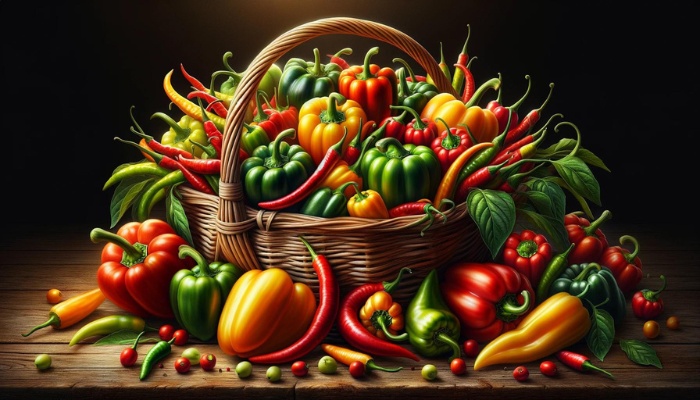You can revolutionize your kitchen by growing hydroponic peppers of all types, right from the comfort of your home.
You’ll start by selecting a hydroponic system that fits your space and budget, then move on to choosing from the wide array of pepper varieties available.
From there, it simply comes down to maintaining your system so it supports the plants’ growth until harvest time.
Choosing Your Hydroponic System
Selecting the right hydroponic system is vital for the successful cultivation of hydroponic peppers because each system offers unique benefits and challenges tailored to different growth requirements and space constraints.
You need to consider several factors, including controlling water temperature and lighting options, which are vital for the growth of your peppers.
Water temperature in your hydroponic system plays a pivotal role in nutrient uptake and root health.
Ideally, you’ll want to maintain a water temperature between 65°F and 80°F to ensure optimal growth. This range supports oxygen availability in the water, preventing root diseases and promoting healthy development.
Lighting options are equally important; peppers thrive under full spectrum LED lights that mimic natural sunlight.
The advantage of using LED lights includes the ability to adjust the light intensity and spectrum, catering specifically to the growth stage of your peppers.
This not only enhances photosynthesis but also controls the vegetative and flowering phases, ensuring a bountiful harvest.
Selecting Pepper Varieties
Choosing the appropriate variety of peppers for your hydroponic garden hinges on understanding the specific growth habits and environmental needs of each type.
To navigate through the vast array of options, it’s crucial to consider several factors that will influence your success and the quality of your harvest.
Here are four key aspects to consider when selecting pepper varieties:
- Pepper Flavors: Each variety has a unique flavor profile, ranging from sweet and mild to intensely hot. When making your selection, consider your culinary preferences and the planned usage of your peppers.
- Growth Habits: Some pepper plants are more compact, making them ideal for limited spaces while others require more room to flourish. Understanding the growth pattern of each variety will help you plan your hydroponic setup effectively.
- Disease Resistance: Opt for varieties with a strong resistance to common diseases. This trait is especially important in a hydroponic environment where plants are grown in close proximity to reduce the risk of disease spread.
- Yield Potential: Some varieties are known for their high yield, ensuring you get the most out of your hydroponic garden.
Setting Up Your Grow Space
The success of your hydroponic peppers hinges on two critical factors: lighting solutions and temperature control.
Peppers thrive under full spectrum LED lights, which mimic the sun’s natural spectrum and promote healthy growth and fruiting.
These lights should be positioned strategically to ensure even light distribution, avoiding shaded areas that could hinder plant development.
The duration of light exposure should also be controlled as most pepper varieties require between 14 and 18 hours of light per day.
Temperature control is equally important. Peppers flourish in temperatures ranging from 65°F to 80°F (18°C to 27°C). Maintaining this range ensures optimal growth and fruit production.
Utilizing a combination of heaters, fans, or air conditioning units can help stabilize your grow space’s temperature.
Investing in a quality thermostat will provide you with the ability to monitor and adjust the temperature as needed, ensuring your hydroponic peppers have the ideal environment to thrive in.
Nutrient and Ph Management
The health of your plants heavily depends on the balance of nutrient solutions and pH levels, which influence their growth, yield, and overall health. Here’s a concise guide to keep you on track:
- Regularly Test Water Quality: Use reliable meters to measure the pH and nutrient concentration of your solution. Ideal pH levels for hydroponic peppers range between 5.5 and 6.5. Deviations outside this range can hinder nutrient uptake, affecting plant health.
- Choose the Right Nutrient Mix: Select a hydroponic nutrient solution specifically formulated for peppers. This ensures your plants get the right balance of macro and micronutrients essential for their development.
- Adjust According to Water Sources: Be mindful of the water source you’re using. Different sources can have varying pH levels and mineral contents, which might necessitate adjustments to your nutrient solution.
- Sync with Lighting Schedules: Align nutrient feedings with your lighting schedules. Peppers thrive under consistent light, and coordinating nutrient delivery with these cycles promotes better absorption and utilization of nutrients.
Harvesting and Pruning Tips
Harvesting should occur when peppers reach their full color—indicative of maturity—and firmness. This timing is critical as it directly impacts flavor and nutritional value.
Use clean, sharp scissors or pruners to cut the peppers from the plant, leaving a short stub of stem attached to reduce the risk of plant damage.
Pruning is essential for maintaining plant health and maximizing yield. Remove any dead or yellowing leaves to prevent the spread of disease and allow for better air circulation.
Focus on eliminating nonfruiting branches to redirect the plant’s energy toward fruit production. This strategy, combined with effective pollination methods and pest control strategies, will enhance fruit set and quality.
Hand pollination can be a beneficial technique in enclosed hydroponic setups to ensure pollination, and organic pest control methods maintain plant health without introducing harmful chemicals.
By adhering to these harvesting and pruning tips, you’ll optimize your hydroponic pepper production, leading to bountiful and healthy yields.

